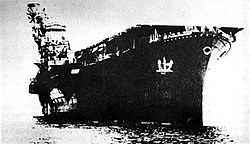Hiyō
|
The Hiyō
|
||||||||||||||||||
|
||||||||||||||||||
|
||||||||||||||||||
|
||||||||||||||||||
|
||||||||||||||||||
|
||||||||||||||||||
The Hiyō ( Japanese 飛鷹 ) was an aircraft carrier of the Japanese Navy in World War II and type ship of the Hiyō class .
history
Construction and construction
Like her sister ship Jun'yō, she was originally planned as a passenger ship for the shipping company Nippon Yusen Kaisha , but was completed as an aircraft carrier.
Calls
From the commissioning it was used in the area around Guadalcanal . Shortly before the battle of the Santa Cruz Islands , a fire broke out in the generator room. The planes were brought to the Junyō and the Hiyō ran back to Truk to be repaired there.
On June 10, 1943, near Miyake Island, she was hit in the bow and boiler rooms by two torpedoes from the American submarine USS Trigger . Boiler rooms 1 and 2 were flooded. The team was able to repair the Hiyo so far that they could run to Tateyama and on to Yokosuka on their own . While she was being repaired, her planes were used on the ryūhō .
fate
On June 19 and 20, 1944, she took part in the Battle of the Philippine Sea. In the course of this battle, the Hiyō was hit by a bomb on the bridge on June 20, whereby the commander Captain Yokio was seriously injured and almost the entire bridge crew was killed. Shortly thereafter, she was attacked by torpedo planes and a torpedo hit near the right engine room. The ship lost speed quickly, but was able to continue running with the left propeller. Several fires broke out that were quickly brought under control. As with the Taihō the day before, however, jet fuel vapors were distributed in the ship and exploded, setting the entire stern on fire. At 7:32 p.m. the Hiyō sank . 1000 men of the crew could be rescued by destroyers.
See also
literature
- Mark Stille, Tony Bryan: Imperial Japanese Navy Aircraft Carriers 1921–45. Osprey Publishing, 2005, ISBN 978-1-84176-853-3 .
